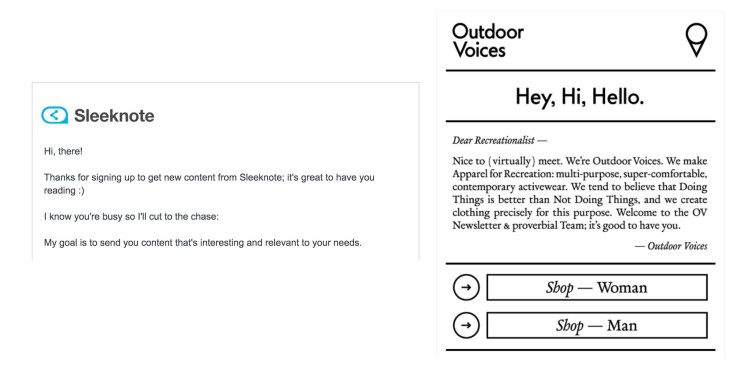1. The Welcome Email
Just like meeting someone for the first time, the welcome email is your subscriber’s first experience with your brand, and therefore, you should aim to make a good first impression. Keep the messaging sincere and provide useful information and links to help your subscriber discover your brand and offerings further. Take a look at these great examples from Sleeknote and Outdoor Voices.

What we like about the emails above:
- It reminds subscribers why they are receiving the email
- It sets expectations of what is to come in upcoming emails
- It gives subscribers an opportunity to know the brand better, discover the website and a chance to browse their products.
2. The Transactional Email
As opposed to a marketing email which is more general, and often ad-hoc, the transactional email is an email that is automatically triggered by an action. Purchase receipt, password reset, order confirmation and subscription renewal emails are some examples.
As an example, first up is the order confirmation email by Dollar Shave Club, followed by an enrolment confirmation email from Udemy.

Both these brands have growth hacked their transactional emails to upsell and cross-sell. It’s safe to say someone who receives an email post order or purchase is more engaged and invested in a brand, and therefore is more likely to upgrade or buy more.
3. The Reminder Email
In reality, your subscribers are busy creatures, and they could easily miss your emails or get distracted just as they are about to hit the checkout button. The reminder email is a great way to send a gentle nudge towards completing an action – whether it’s to download, purchase, subscribe, complete a form.
For example, e-Commerce businesses use the abandoned cart email to recapture what would otherwise be lost sales. Brooklinen goes a step further to incentivise shoppers with free shipping to encourage a purchase.

4. The Nurturing Email
According to a study by Gleanster, a staggering 50% of qualified leads are not ready to purchase from brands, while HubSpot found that only 25% are prepared to buy. This is where nurturing emails that are not salesy or pushy come in play to educate, deliver value, and keep your brand top of mind until a lead is ready to take the next step. These emails aim to be educational (example below), helpful, highlight a missed opportunity or good deal or build trust.

Nurturing emails are also used to re-engage users as discussed in the next point.
5. The Disengaged User Email
As the saying goes, acquiring an entirely new user is more expensive than re-engaging an existing user. It’s not uncommon for subscribers or leads to go unresponsive, so the disengaged user email is used to reconnect in those cases.
Typeform used this lighthearted email to get customers to return to the website and use the service:

6. The Update Email
If you are a product-centric business, keeping subscribers up to date on new product features or a major update is necessary. Product updates can also be used to re-engage those who needs were not met at the time but can now be met with the new features. Sprout Social did just that in their email:

Other updates like the opening of a new office and changes to policies are both essential and a reason to keep in contact with your subscribers.
Ready to start your own email marketing? You will find our Email Marketing 101 resource especially helpful, do check it out.
Sources:
https://www.slideshare.net/kevmil72/gleanster-lead-nurturing-webinar-draft-012411-final
reallygoodemails.com
https://blog.hubspot.com/blog/tabid/6307/bid/30725/6-lead-nurturing-emails-every-business-should-send.aspx